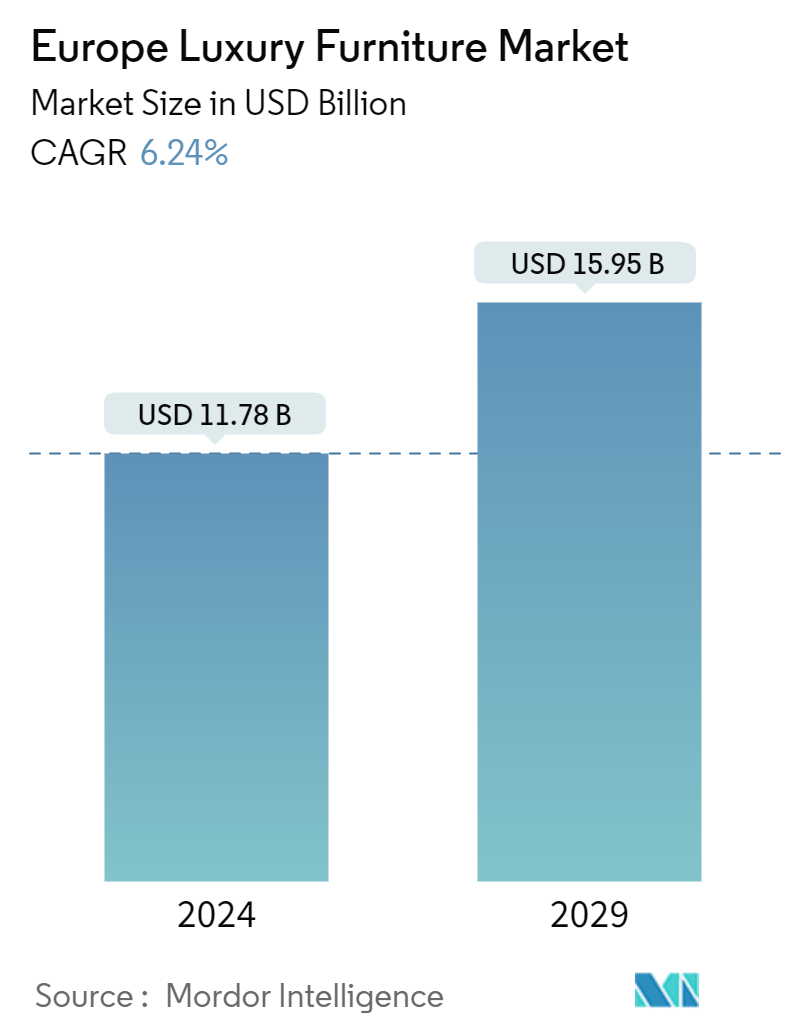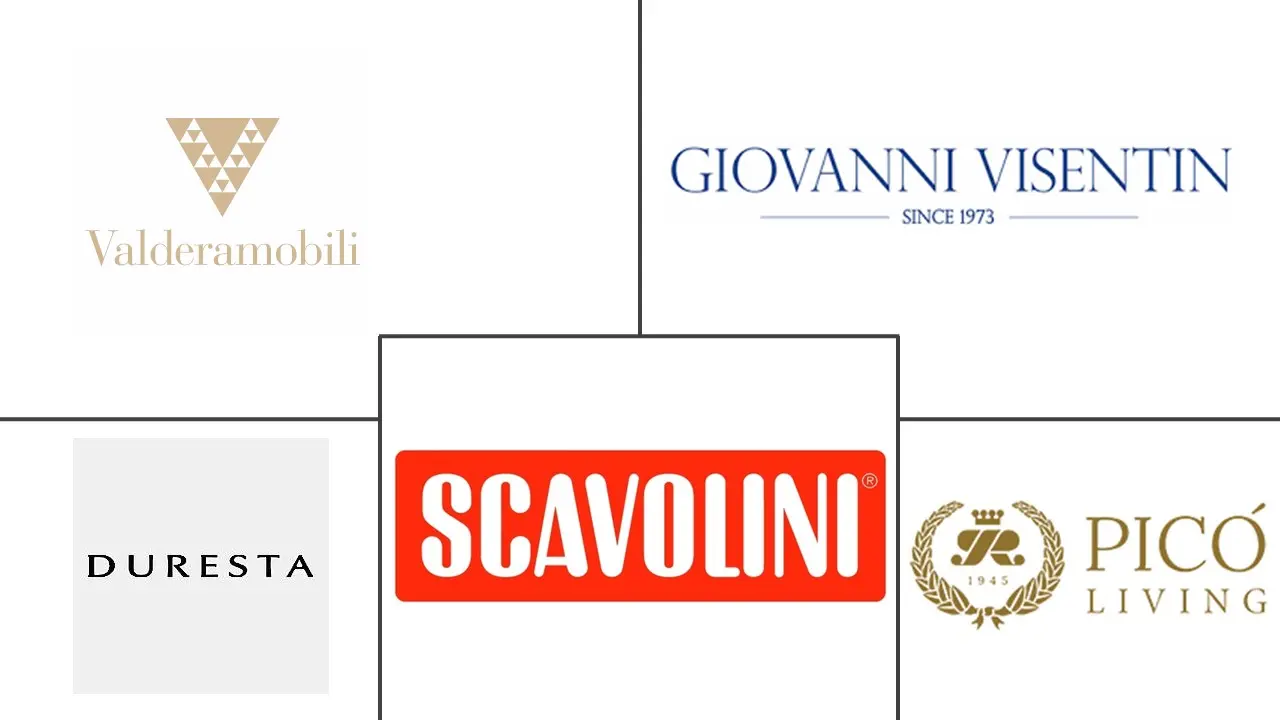Market Size of Europe Luxury Furniture Industry

| Study Period | 2020 - 2029 |
| Base Year For Estimation | 2023 |
| Market Size (2024) | USD 11.78 Billion |
| Market Size (2029) | USD 15.95 Billion |
| CAGR (2024 - 2029) | 6.24 % |
| Market Concentration | Low |
Major Players
*Disclaimer: Major Players sorted in no particular order |
Europe Luxury Furniture Market Analysis
The Europe Luxury Furniture Market size is estimated at USD 11.78 billion in 2024, and is expected to reach USD 15.95 billion by 2029, growing at a CAGR of 6.24% during the forecast period (2024-2029).
The European luxury furniture sector holds a prominent position globally, excelling not just as a producer but also as a significant consumer and exporter. Europe's furniture production alone commands nearly 40% of the global market.
China's sizable population and growing affluence have fueled a robust demand for furniture, which, in turn, is bolstering the European furniture industry. Consumers' growing inclination to allocate a larger portion of their disposable income to floor coverings and furnishings is fueling this trend. Additionally, factors such as urbanization, real estate growth, robust GDP, and economic stability further contribute to Europe's furniture industry surge.
Europe emerges as a dominant player in the global wooden furniture export market, with its primary markets including the European Union, the United States, Hong Kong, Japan, and Vietnam. Notably, Europe also imports furniture, particularly from countries like Italy and Germany.
Europe's thriving furniture industry is underpinned by its abundant natural resources. A noteworthy development is the rise of furniture malls in Europe, a response to the surging consumer demands.
Europe Luxury Furniture Industry Segmentation
Luxury furniture is conducive to sumptuous living and includes elements that are elegant, sumptuous, and indulgent.
The European luxury furniture market is segmented by product type, end-user, distribution channel, and geography. By product type, the market is sub-segmented into lighting, tables, chairs and sofas, accessories, bedrooms, cabinets, and other product types. By end-user, the market is sub-segmented into residential and commercial. The distribution channel of the market is sub-segmented into home centers, flagship stores, specialty stores, online, and other distribution channels. Geography the market is sub-segmented into Germany, the United Kingdom, France, Spain, Russia, Italy, and the rest of Europe. The report offers market size and forecasts for the European luxury furniture market in value (USD) for all the above segments.
| Product Type | |
| Lighting | |
| Tables | |
| Chairs and Sofas | |
| Accessories | |
| Bedroom | |
| Cabinets | |
| Other Product Types |
| End-User | |
| Residential | |
| Commercial |
| Distribution Channel | |
| Home Centers | |
| Flagship Stores | |
| Specialty Stores | |
| Online | |
| Other Distribution Channels |
| Geography | |
| Germany | |
| United Kingdom | |
| France | |
| Spain | |
| Russia | |
| Italy | |
| Rest of Europe |
Europe Luxury Furniture Market Size Summary
The European luxury furniture market is a significant player on the global stage, both in terms of production and consumption. The region's furniture industry benefits from a strong demand driven by factors such as urbanization, real estate growth, and economic stability. Europe is a leading exporter of wooden furniture, with key markets including the European Union, the United States, and Asia. The rise of e-commerce has transformed the market dynamics, allowing European luxury furniture brands to reach a global audience and expand their customer base. This shift has increased competition and provided consumers with greater convenience and choice, as they can now explore and purchase luxury furniture online.
Italy stands out as a dominant force in the luxury furniture sector, known for its high-quality craftsmanship and design excellence. Italian brands have a robust distribution network and offer a wide range of styles, from classic to modern, appealing to diverse customer preferences. The market is highly fragmented, with many small and medium-sized companies specializing in handcrafted luxury furniture. This fragmentation presents both challenges and opportunities, allowing niche players to thrive by focusing on specific market segments. Major players in the market include Duresta Upholstery Ltd., Muebles Pico, Valderamobili, Giovanni Visentin, and Scavolini, each contributing to the rich tapestry of Europe's luxury furniture landscape.
Europe Luxury Furniture Market Size - Table of Contents
-
1. MARKET INSIGHTS AND DYNAMICS
-
1.1 Market Overview
-
1.2 Market Drivers
-
1.3 Market Restraints
-
1.4 Value Chain/Supply Chain Analysis
-
1.5 Porter's Five Forces Analysis
-
1.5.1 Threat of New Entrants
-
1.5.2 Bargaining Power of Buyers/Consumers
-
1.5.3 Bargaining Power of Suppliers
-
1.5.4 Threat of Substitute Products
-
1.5.5 Intensity of Competitive Rivalry
-
-
1.6 Impact of COVID-19 on the Market
-
-
2. MARKET SEGMENTATION
-
2.1 Product Type
-
2.1.1 Lighting
-
2.1.2 Tables
-
2.1.3 Chairs and Sofas
-
2.1.4 Accessories
-
2.1.5 Bedroom
-
2.1.6 Cabinets
-
2.1.7 Other Product Types
-
-
2.2 End-User
-
2.2.1 Residential
-
2.2.2 Commercial
-
-
2.3 Distribution Channel
-
2.3.1 Home Centers
-
2.3.2 Flagship Stores
-
2.3.3 Specialty Stores
-
2.3.4 Online
-
2.3.5 Other Distribution Channels
-
-
2.4 Geography
-
2.4.1 Germany
-
2.4.2 United Kingdom
-
2.4.3 France
-
2.4.4 Spain
-
2.4.5 Russia
-
2.4.6 Italy
-
2.4.7 Rest of Europe
-
-
Europe Luxury Furniture Market Size FAQs
How big is the Europe Luxury Furniture Market?
The Europe Luxury Furniture Market size is expected to reach USD 11.78 billion in 2024 and grow at a CAGR of 6.24% to reach USD 15.95 billion by 2029.
What is the current Europe Luxury Furniture Market size?
In 2024, the Europe Luxury Furniture Market size is expected to reach USD 11.78 billion.

